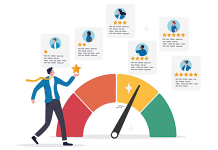The lingering effects of Covid-19 lockdowns, the persistent supply chain disruptions and increasing fears of a global recession have injected a great deal of uncertainty into the market.
At the same time, the turn toward digitalization has had significant impacts, both positive and negative, on B2B enterprises. On the one hand, digitalization has dramatically increased market reach. On the other, it has introduced unprecedented levels of competition, requiring B2B organiza- tions to contend not only with rivals down the street or in the next town, but also on the far side of the world.
In order to survive and thrive, B2B concerns must not only effectively adapt to ongoing market volatility but also to an increasingly crowded and competitive operating environment. The good news is that, while market conditions may be more challenging than ever before, the marketing tools available to business leaders are dramatically improved.
Among the most powerful of these tools is also the most ubiquitous. Social media is not just a platform for entertainment and socializing, nor are its marketing capacities limited only to business-to-consumer (B2C) endeavors. Rather, social media can be an incredibly effective tool for helping B2B businesses meet and exceed their sales goals. This article describes best practices for tapping into social media trends in order to galvanize sales.
Flexibility, Differentiation, Segmentation and Alignment
One of the most significant benefits of using social media to support B2B sales is the flexibility and responsiveness the channel provides. Today’s wide variety of social media platforms gives marketers unprecedented capacities for customer segmentation and targeting.
For instance, using social media analytics, you can not only more effectively and efficiently define who your target customer is, but also how and where to reach them online.
LinkedIn, for example, is a particularly important platform for B2B marketers, with an overwhelming majority of B2B marketers citing the platform as their preeminent lead generation tool.
But while LinkedIn is certainly one of the most important channels for B2B marketing, it is by no means the only viable platform. Indeed, an effective social media marketing strategy requires both differentiation and flexibility, the capacity to go where customers are, and to align messaging strategies to their needs.
This requires B2B marketers to cultivate a comprehensive understanding of the most critical social media sites, the audiences who use them, and the messaging strategies specific to them. If you find that a significant segment of your target customer base deploys platforms such as YouTube, Instagram or TikTok for business research, your messaging must adapt accordingly.
This means, ultimately, that your social media strategy must be flexible enough to align with the behaviors, expectations and content standards of each platform. Thus, you may find yourself constructing robust, research-supported, text-heavy content for LinkedIn and brief explainer videos for YouTube in order to deliver essentially the same message.
Timeliness and Trendiness
No matter how effective your content development and channel strategy may be, if you don’t time your campaigns well, you’re not going to get the results you want. This is because social media, more than any other marketing channel, is incredibly dynamic.
There is so much social media content generated every second of every day that you must be strategic if you want to stay in view of the target customer. The effectiveness of your social media marketing depends in large part on understanding who your audience is, which platforms they use, and, especially, when and how they use them.
It’s imperative, for example, to align your posting schedules with the day and time your audience is likely to be most active on the site in order to increase the likelihood that the post will be seen. If your goal is to increase sales, you simply can’t assume that your target audience will scroll long enough to find you.
Timing is everything in the ever-changing world of social media.
That also includes timing your entrance into new channels and platforms to remain on-trend and to ensure you’re always meeting your target audience where they are and where they’re going. The metaverse, for example, though still very much under development, is already emerging as a crucial platform that B2B marketers will ignore at their peril.
Cultivating a robust presence in the metaverse today will solidify one’s position as a leader and pioneer in this channel. As increasing numbers of consumers, entrepreneurs and business leaders transition to the platform, having an established brand in the metaverse provides a distinct competitive advantage. Your sales funnel can already be up and seamlessly running before your rivals even show up to the party.
The B2B marketplace is more crowded and competitive than ever before. However, thanks to the tremendous power of social media, B2B marketers have an unprecedented capacity to reach a truly global market. By tapping into social media trends through the creation of flexible, timely, differentiated and responsive social media marketing strategies, business leaders can exceed the loftiest sales goals.




